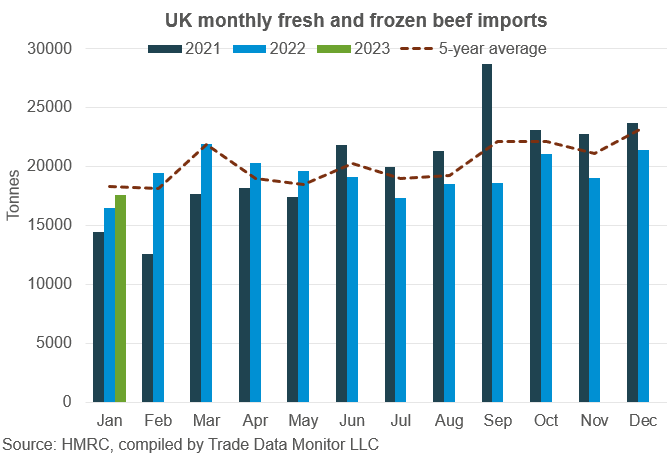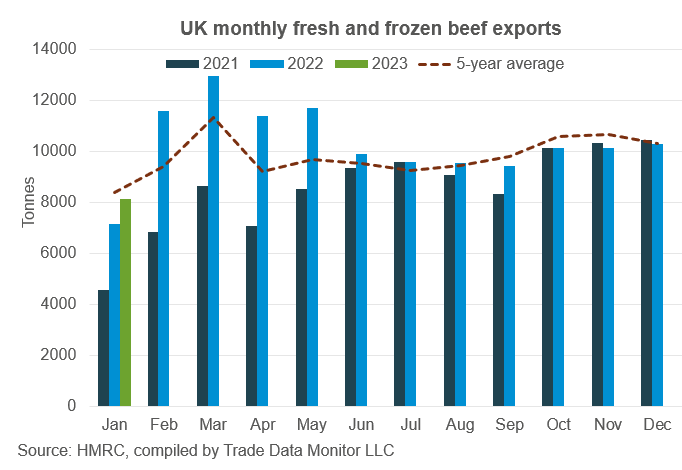UK beef trade sees year-on-year increase in January
Friday, 31 March 2023
Imports
In January, UK fresh and frozen beef imports came to 17,600 tonnes according to HMRC. This followed seasonal trends with a month-on-month (MOM) decline of 17.8% compared to December’s total. Fresh and frozen boneless beef continued to make up the majority of beef imports, consisting of 86.7% of the total, in line with the 2022 average.
Meanwhile when compared to January 2022, imports were up 6.7%. The main reason behind this this was imports of fresh beef from Ireland as the volume imported across the Irish Sea totalled 9,050 tonnes for the month, a 27% rise year-on-year (YOY). For more detail on Irish beef, check out our recent article looking at historical and projected Irish beef trends.
Greater volumes of fresh beef to the UK outweighed the 10.2% decrease in frozen beef imports, which stood at just 6,300 tonnes in January (HMRC). As the EU accounts for the majority of frozen beef imports, reductions from exporters like France and Spain greatly contributed to this. Most notably, the Netherlands saw a 71.2% fall in imports YOY, coming to just 164 tonnes in January. Yet we did see imports of German frozen beef increase by 21.5% YOY, totalling 1,250 tonnes. This continues the trend of a shift in frozen beef supply seen throughout 2022.
With the potential for imports to reduce by 2% on the year in 2023, we could see imports dampened over the coming months.
Exports
Moving onto beef exports, we saw quantities of beef leaving the UK reduce by 20.7% MOM, totalling 8,100 tonnes for January. This was mainly driven by exports to Hong Kong reducing by 1100 tonnes (-93.4%) as demand has dropped in part from reduced demand from tourism. However now that the market has re-opened following the relaxation of COVID restrictions, it will be interesting to see how beef imports from the UK progress over the coming months. Looking to other markets, despite exports to France decreasing by 500 tonnes (-22.4%) on the month, YOY exports to France were up 66% at 1,900 tonnes.
This, alongside YOY export increases to Ireland, The Netherlands and Germany, outweighed export decreases to Canada and Japan to name a few, helping to drive a 13.7% YOY increase in fresh and frozen beef exports.
The YOY increase in total exports was driven by increases to fresh beef exports (22.1%) as frozen beef saw a marginal 4.7% decline in January. More specifically, fresh carcases and bone-in beef saw large 66.4% and 49.3% increases YOY at 1,500 and 900 tonnes respectively for January albeit from a small base. Take a look at AHDB’s beef outlook to see whether January’s YOY export increase will hang around for the remainder of this year.
Sign up for regular updates
You can subscribe to receive Beef and Lamb market news straight to your inbox. Simply fill in your contact details on our online form.
While AHDB seeks to ensure that the information contained on this webpage is accurate at the time of publication, no warranty is given in respect of the information and data provided. You are responsible for how you use the information. To the maximum extent permitted by law, AHDB accepts no liability for loss, damage or injury howsoever caused or suffered (including that caused by negligence) directly or indirectly in relation to the information or data provided in this publication.
All intellectual property rights in the information and data on this webpage belong to or are licensed by AHDB. You are authorised to use such information for your internal business purposes only and you must not provide this information to any other third parties, including further publication of the information, or for commercial gain in any way whatsoever without the prior written permission of AHDB for each third party disclosure, publication or commercial arrangement. For more information, please see our Terms of Use and Privacy Notice or contact the Director of Corporate Affairs at info@ahdb.org.uk © Agriculture and Horticulture Development Board. All rights reserved.



